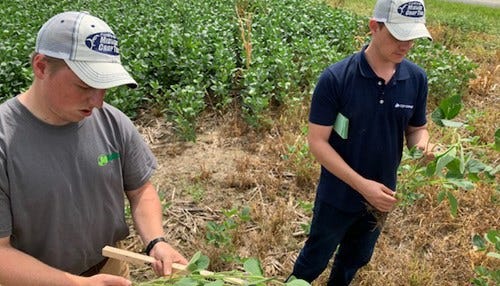2019 Indiana Crops ‘Bottom of the Worst Ever’
 (image courtesy of Wes Mills)
(image courtesy of Wes Mills)
Subscriber Benefit
As a subscriber you can listen to articles at work, in the car, or while you work out. Subscribe Now“In terms of maturity, I would say it’s right down there at the bottom of the worst ever,” proclaimed Brian Grete, editor of the Iowa-based Pro Farmer grain marketing newsletter, about the 2019 Indiana corn and soybean crops. Last week, Grete led a team of 60 field scouts across Indiana to get a late-season assessment of Indiana’s major grain crops.
“One of my most mature corns samples I pulled (from the field) would have been the least mature in a normal year,” said Grete.
For the past 27 years Pro Farmer, a subsidiary of Farm Journal magazine, has dispatched teams of agronomists, farmers, grain marketers and grain buyers across seven states of the Midwest to estimate how many bushels of corn and soybeans American farmers will potentially harvest in the fall.
Indiana has struggled all season and the latest USDA report doesn’t change that, showing 32 percent of corn rated as good-to-excellent and 27 percent is poor to very poor. The remaining 41 percent is fair. The Hoosier crop is tied with Ohio as the worst corn among the top 18 corn-growing states in the nation. And soybeans are not much better.
“All the talk about the immaturity and being delayed and the lateness, it lived up to that billing, unfortunately,” said Grete after spending a day in Indiana fields.
After traveling through most central Indiana counties, a team of Pro Farmer analysts used the data to determine the size of the crop, and it doesn’t show much promise.
The company put the 2019 statewide average corn yield at just over 161 bushels an acre, a 12 percent drop from Pro Farmer’s 2018 projections of 182 bushels an acre.
Unlike corn, the publication does not project soybean yield estimates since that crop still has time in the season to grow. But the scouts do measure pods on each plant in a three-foot by three-foot section of a field. It’s a tedious task, Grete admits, but one that has proven to be an accurate way to measure crop potential. But the potential looks poor with the Indiana soybean pod count tumbling 30 percent from 2018 estimates.
“It definitely is the soybean pod counts more than the corn yields that are the surprise,” Grete continued.
Grete says the crops show a lot of immaturity, the result of late planting. Grete estimates two-thirds of Indiana corn was planted in June when the crop is typically in the ground by early May. Once farmers did get their crops planted, rain showers became nearly non-existent.
“We’re just so late that we need weeks, extra weeks, and we’re also going to need some moisture and late-season moisture (for beans). It’s going to need some time, it’s gonna need a lot of time to get to the finish line.”
A lot more time needed before the first frost hits and effectively stops the growing season…time that Indiana farmers and their crops may not get.
